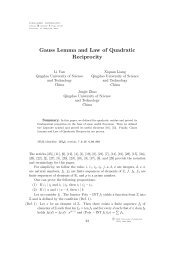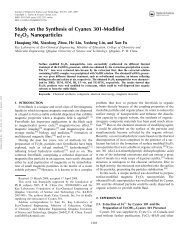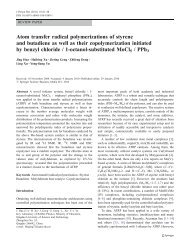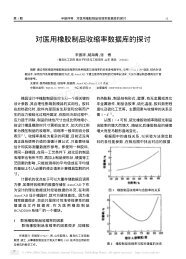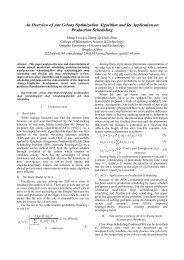Electrospinning of Hyaluronic Acid (HA) and HA/Gelatin Blends
Electrospinning of Hyaluronic Acid (HA) and HA/Gelatin Blends
Electrospinning of Hyaluronic Acid (HA) and HA/Gelatin Blends
Create successful ePaper yourself
Turn your PDF publications into a flip-book with our unique Google optimized e-Paper software.
<strong>Electrospinning</strong> <strong>of</strong> <strong>Hyaluronic</strong> <strong>Acid</strong> (<strong>HA</strong>) <strong>and</strong> <strong>HA</strong>/<strong>Gelatin</strong> <strong>Blends</strong> 115<br />
processability to fabricating into novel nan<strong>of</strong>ibrous<br />
composites.<br />
<strong>Hyaluronic</strong> acid, as a naturally occurring linear polysaccharide,<br />
consists <strong>of</strong> repeating disaccharide units (b-1,4-<br />
D-glucuronic acid <strong>and</strong> b-1,3-N-acetyl-D-glucosamine), is<br />
the main component <strong>of</strong> the ECM <strong>of</strong> connective tissues, <strong>and</strong><br />
has many important biological functions. [33–35] Due to its<br />
excellent properties <strong>of</strong> biocompatibility <strong>and</strong> biodegradability,<br />
<strong>HA</strong> <strong>and</strong> its derivatives have been used extensively in<br />
biomedical field, for example in wound dressings, tissue<br />
scaffolds, arthritis treatment, drug delivery, <strong>and</strong> components<br />
<strong>of</strong> implant materials. [35–38] However, medical studies<br />
on <strong>HA</strong> nan<strong>of</strong>ibrous membranes have hardly been reported<br />
in spite <strong>of</strong> its importance in medical applications.<br />
Generally, it was very difficult to carry out electrospinning<br />
<strong>of</strong> <strong>HA</strong> aqueous solution. The molecular weight <strong>of</strong><br />
native <strong>HA</strong> is typically several million. The unusually high<br />
viscosity <strong>and</strong> surface tension <strong>of</strong> <strong>HA</strong> were thought to be the<br />
key factors that hinder the electrospinning <strong>of</strong> <strong>HA</strong> solution.<br />
Additionally, the strong water retention ability <strong>of</strong> <strong>HA</strong> might<br />
lead to the fuse <strong>of</strong> nan<strong>of</strong>ibers electrospun on the collector<br />
due to the insufficient evaporation <strong>of</strong> solvents in electrospinning.<br />
The fabrication <strong>of</strong> <strong>HA</strong> into nan<strong>of</strong>ibrous nonwoven<br />
membranes from aqueous solution was successfully<br />
carried out only after the development <strong>of</strong> blowing-assisted<br />
electrospinning. [9]<br />
In this paper, the electrospinning process <strong>of</strong> <strong>HA</strong> <strong>and</strong><br />
hyaluronic acid/gelatin (<strong>HA</strong>-GE) blends in mixed solvents<br />
has been investigated. The main objectives are as follows:<br />
(a) Explore the electrospinning process <strong>of</strong> pure <strong>HA</strong><br />
solution in water <strong>and</strong> mixed solvents, find the key factor<br />
which hinders the electrospinning <strong>of</strong> <strong>HA</strong> aqueous solution,<br />
<strong>and</strong> provide the solution to this spinning difficulty.<br />
(b) Find a novel <strong>and</strong> simple way to electrospin <strong>HA</strong><br />
solutions with the common electrospinning setup.<br />
(c) Investigate the effects <strong>of</strong> GE on the electrospinning<br />
process <strong>of</strong> <strong>HA</strong> solutions. The characteristics <strong>of</strong> GE, such as<br />
relatively lower molecular weight <strong>and</strong> amphiphilic property,<br />
might favor the electrospinning <strong>of</strong> <strong>HA</strong> solution.<br />
(d) Obtain <strong>HA</strong>-GE nan<strong>of</strong>ibrous membranes with various<br />
blending ratios. The <strong>HA</strong>-GE nan<strong>of</strong>ibrous membranes with<br />
different compositions <strong>and</strong> sized scale could have different<br />
clinical applications to drug delivery, wound healings, <strong>and</strong><br />
tissue engineering scaffolds.<br />
The present report shows that with the aid <strong>of</strong> N,Ndimethylformamide<br />
(DMF), <strong>HA</strong> can be electrospun successfully<br />
with common electrospinning setup at neutral pH,<br />
<strong>and</strong> <strong>HA</strong>-GE aqueous solutions were first co-electrospun to<br />
produce <strong>HA</strong>-GE composite fibrous non-woven membranes.<br />
Experimental Part<br />
Materials<br />
<strong>Hyaluronic</strong> acid (sodium salt, Mw ¼ 2 000 000) was purchased<br />
from Dali Co. (Nanning, China). Polymers <strong>of</strong> GE Type A<br />
(Approx. 220 Bloom, Mn ¼ 80 000), extracted from porcine<br />
skin by acidic process, were purchased from Sanhesheng<br />
<strong>Gelatin</strong> Co. (Wenzhou, China). DMF <strong>and</strong> ethanol were<br />
obtained from Beijing Chem. Co. (Beijing, China). All the<br />
solvents were used without further purification.<br />
Preparation <strong>of</strong> Spinning Solution<br />
<strong>HA</strong> Solutions in Water System<br />
Transparent aqueous solutions <strong>of</strong> <strong>HA</strong> were prepared by dissolving<br />
a specific amount <strong>of</strong> <strong>HA</strong> powder in the mixed solvents<br />
consisting <strong>of</strong> distilled water (w) <strong>and</strong> ethanol (e) (w/e ¼ 9/1,<br />
volume ratio). Pure <strong>HA</strong> solutions with concentrations <strong>of</strong> 1.3 w/<br />
v% (w in grams <strong>and</strong> v in milliliters) <strong>and</strong> 1.5 w/v% were<br />
obtained.<br />
1.5 w/v% <strong>HA</strong> Solutions in DMF/Water System<br />
Dissolve certain amounts <strong>of</strong> <strong>HA</strong> powder in DMF under gentle<br />
stirring for 10 min, <strong>and</strong> then add a specific amount <strong>of</strong> distilled<br />
water into the <strong>HA</strong> solution according to the volume ratio <strong>of</strong><br />
DMF to water (2, 1.5, 1 <strong>and</strong> 0.5), respectively, <strong>and</strong> continue to<br />
stir the solution for 20 min until the solution became<br />
transparent. The spinning solution <strong>of</strong> 1.5 w/v% <strong>HA</strong> in DMF/<br />
water system (2, 1.5, 1 <strong>and</strong> 0.5) was prepared.<br />
<strong>HA</strong>-GE <strong>Blends</strong> Solutions<br />
1.875 w/v% <strong>HA</strong> in DMF/water (volume ratio ¼ 1.5) solution<br />
was prepared using the same procedure as above. 1.5, 3, 4.5, 6,<br />
<strong>and</strong> 7.5 w/v% GE solutions with the solvent being pure water<br />
was prepared at 40 8C under gentle stirring for 20 min. Add the<br />
GE solution into the <strong>HA</strong> solution with specific volumes to<br />
obtain the <strong>HA</strong>-GE solutions (<strong>HA</strong>/GE ¼ 100/20, 100/40, 100/<br />
60, 100/80, 100/100, weight ratio), <strong>and</strong> in each solution the<br />
concentration <strong>of</strong> <strong>HA</strong> was fixed at 1.5 w/v%.<br />
<strong>Electrospinning</strong><br />
All electrospinning solutions, spinneret, <strong>and</strong> the environmental<br />
temperatures were controlled at 40 3 8C. The electrospinning<br />
solutions were placed into a 5 ml syringe with a capillary tip<br />
having an inner diameter <strong>of</strong> 0.3 mm. A syringe pump was used<br />
to feed the polymer solution <strong>and</strong> the feeding rate was fixed<br />
at 60 ml min 1 . A high-voltage power supply was employed<br />
to generate the electric field (0–50 kV). The applied voltage<br />
was fixed at 22 kV. The tip-to-collector distance was fixed at<br />
15 cm.<br />
<strong>Hyaluronic</strong> acid has strong water retention ability. The residual<br />
water could dissolve the electrospun fibers on the collector<br />
if the aluminum foil was used. In this study, the ethanol bath<br />
was used as a collector because ethanol is a poor solvent for<br />
both <strong>HA</strong> <strong>and</strong> GE. A piece <strong>of</strong> aluminum foil, connecting to the<br />
ground, was immersed in a vessel filled with ethanol. After<br />
electrospinning, the vessel was put into the vacuum oven at<br />
50 8C for 30 min to dry <strong>of</strong>f ethanol <strong>and</strong> other solvents. Then the<br />
aluminum foil can be taken out. Through this method, <strong>HA</strong> <strong>and</strong><br />
<strong>HA</strong>-GE films can be peeled <strong>of</strong>f easily.<br />
Macromol. Rapid Commun. 2006, 27, 114–120 www.mrc-journal.de ß 2006 WILEY-VCH Verlag GmbH & Co. KGaA, Weinheim





